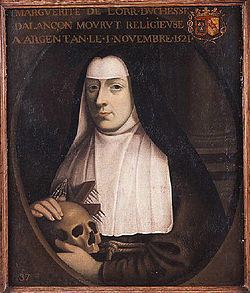Venerated in Roman Catholicism Feast November 2 | Name Margaret Lorraine | |
 | ||
Spouse Rene, Duke of Alencon (m. 1488) Children Charles IV, Duke of Alencon, Anne d'Alencon, Francoise d'Alencon, Johanna von Pfalz-Zweibrucken Parents Yolande, Duchess of Lorraine, Frederick II, Count of Vaudemont Grandchildren Louis, Prince of Conde, Antoine of Navarre Similar People Anne d'Alencon, Antoine of Navarre, Isabella - Duchess of Lorraine, Rene of Anjou, Marguerite de Navarre | ||
Margaret of Lorraine (1463 at the castle of Vaudémont, Lorraine – 2 November 1521 in Argentan, Normandy) was Duchess of Alençon, and a nun of the order of Poor Clares (Ordre des Clarisses). She was beatified in 1921.
Contents
Marriage and children
Margaret was the youngest daughter of Frederick II, Count of Vaudémont and Yolande d'Anjou. She lost her father at the age of seven, and was brought up at Aix-en-Provence by her grandfather René of Anjou. The latter died in 1480 and she was sent back to Lorraine to her brother, René II. He arranged her marriage to René, Duke of Alençon, whom she wed in Toul on 14 May 1488.
Alençon and Margaret had three children:
Widowhood
Left a widow in 1492, she busied herself in the administration of her duchy and the education of her children. When she was relieved of the duties imposed upon her by her position, she decided to renounce the world and retired to Mortagne, to a monastery of religious women who followed the rule of Saint Elizabeth. Later, having brought with her to Argentan some of these nuns, she founded there another monastery which she placed, with the authorization of the pope, under the rule of Saint Clare, modified by the Minor Observants.
She herself took the religious habit in this house and made her vows on 11 October 1520. On 2 November 1521, after having lived an austere life for a year, she died in her modest cell, at the age of sixty-two. Her body, preserved in the monastery of the Poor Clares, and when that monastery was suppressed, was transferred to the church of Saint Germain d'Argentan. In 1793, during the French Revolution, it was profaned and thrown into the common burial place.
The memory of Margaret of Lorraine is preserved in the Martyrologium franciscanum and in the Martyrologium gallicanum. After an invitation made by the bishop of Séez, Jacques Camus de Pontcarré, Louis XIII asked Pope Urban VIII to order a canonical inquiry into the virtues and the miracles of the Duchess.
